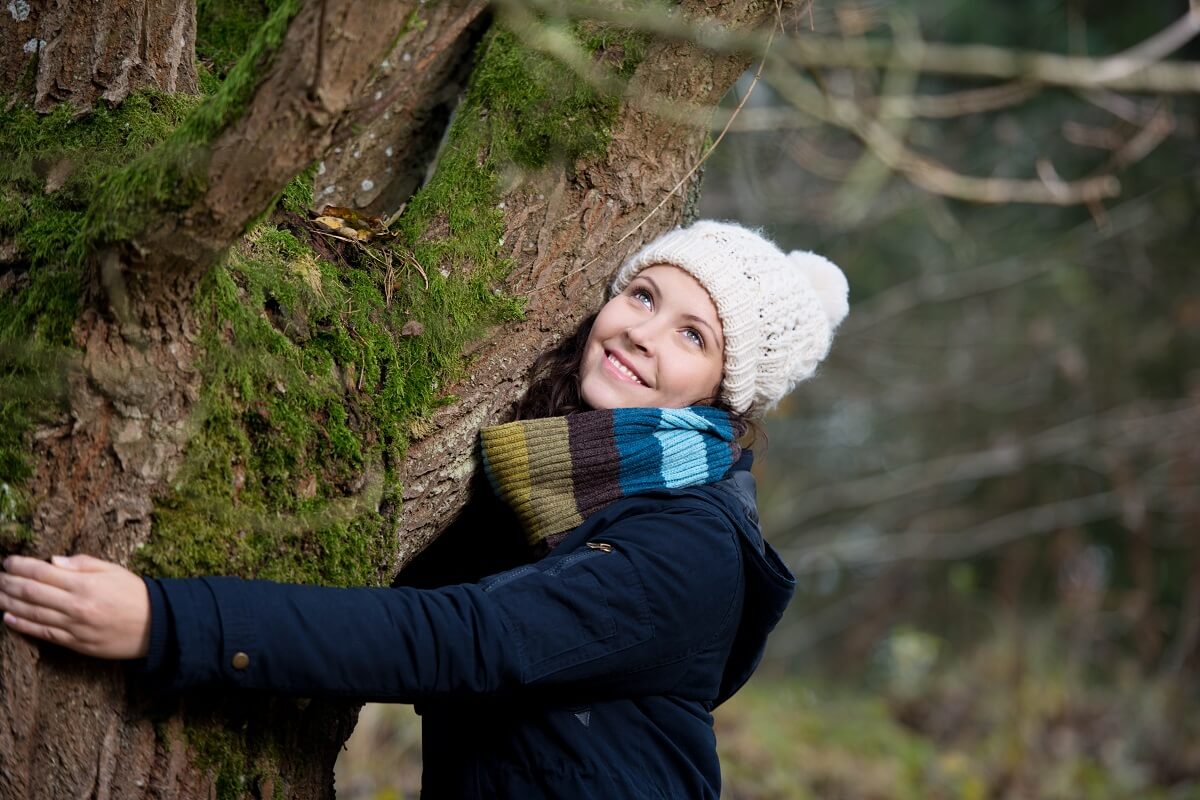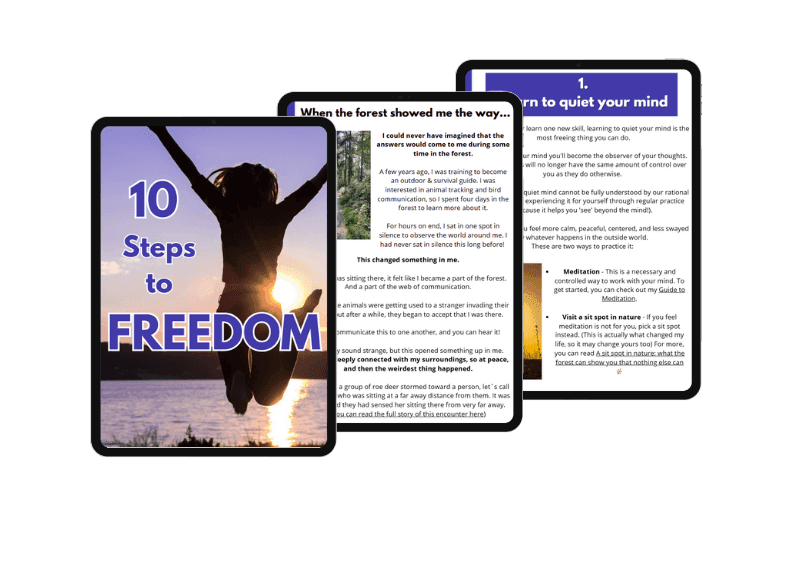In our modern lives, we often rely fully on our technological tools and devices. Also when it comes to navigation. We are no longer able to ´read´ and pick up on nature’s subtle clues.
But the clues are out there. They are all around you. You just need to know where to look, and be willing to pay attention.
When you take the time to observe the subtleties around trees, the behavior of animals, and the movement of the stars, you will be rewarded with some amazing insights that you cannot get any other way.
Learning how to navigate in nature (with natural resources) is a great way to learn and to reconnect with nature 🌿 The more you will pay attention, the more you will be rewarded..!
I’d love to share some of the most important things to learn if you want to navigate in nature. I really believe that these skills bring us closer to nature in a very organice way.
Use them as a starting point when you go outside, and apply them to observe your local landscape and area.
Have fun!
Basic Skills For Navigating In Nature
Before getting into the concrete signs you can pay attention to, there are a few important things to keep in mind when you are trying to interpret nature’s signs.
Asking Questions
What I noticed over the years is that, when we spot a clue and try to interpret it, we tend to jump to conclusions too quickly.
As humans, we have a tendency to want to answer any open questions quickly. This biologically makes sense, because labeling and categorizing things costs less energy than trying to answer an open question. Yet, leaving a question unanswered is what we need to get comfortable with to become good at understanding nature.
Practice this when you go out into nature. Ask questions about what you see without answering them. Just ask the question. Sometimes asking the question is more powerful than trying to find a quick answer (and later find out that you were wrong).
Seeing The Bigger Picture
Another important thing to do when you are trying to interpret a clue, is to zoom in and out. We can easily get convinced of why a tree is growing a certain way when we are looking at it closely, for then to zoom out and see that could not be the case at all.
Therefore, it is extremely important to look at your surroundings on different levels:
- Your location as a part of the greater landscape
- A natural sign (such as a tree) in relation to your its direct surroundings
- The subtle clues around a sign (What do I think I am seeing? Is that really true? What other details do I find here?)
Things are often not what they seem, or we think we understand it, but then it turns out we didn’t have the full picture. Therefore it is vital to be aware of this human trait in all of us.
Natural Clues In The Landscape
When it comes to reading the landscape, there are several things you can pay attention to. Because a lot depends on your local area (climate, wind direction, sun side, terrain), it can only be fully understood by spending time in the area and by being observant over time.

Trees
Trees are a great indicator of the local weather patterns and can therefore point you in the right direction. To determine your direction (North, East, South, West), it is handy to know if you are on the Northern or Southern hemispere, and what the common wind direction is in the area.
In the Northern hemisphere the sun is always in the South, in the Southern hemisphere, the sun is always in the North. There are only two days in the year where the sun rises exactly in the East, and sets exactly in the West. Now you know this, you can easily determine your direction using the sun.
In addition to using the sun to guide you, you can look at trees and plants:
❔How are the trees growing? Are they growing a certain way? Does one side look more bushy than another? What else do I notice?
Trees tend to grow toward the sun. In areas with little wind, you often see the trees and tops of the trees completely leaning toward where the sun shines. This can be an easy way to determine your direction.
For example, your in a desert on the Southern hemisphere. You know that the sun is always in the North, and that the sun heats up the cold night air the quickest right after sunrise (which is in the North-East). All trees are growing in that direction, so you conclude that the tree tops are pointing to the North-East.
👉 Sounds easy enough? Well, this can also be misleading. There might be other factors that you are not aware of that are determining the way the trees are growing. One of those is the wind.
If a tree is standing in a place where it catches a lot of wind, the tree could well be growing away from the wind, while the branches are growing toward the sun. For this reason, always pay attention to all factors in the landscape (other natural elements, rocks, soil, erosion, exposure to the elements etc) and surrounding trees.
This picture shows an example of how a tree can help determine direction. In this case, the common wind direction (where the wind is coming from) is South-West, while the sun is moving along the South side (from East to West).

Plants
Plants can also be a great indication to find your direction.
You can look at plants that are growing on or around trees. Some plants (such as mosses) grow best where the soil retains a lot of water. If you are looking around several trees and you notice there is moss growing on a certain side of all those trees, that can be an indication that the sun is less present in that spot.
Be careful to not draw conclusions too quickly though. Before assuming that this means that the side where the moss grows is the North (if you are on the Northern hemisphere), think of other factors too.
The water could be retained on that side because of reclination of the ground, the type of tree bark, or the type of soil. If the moss grows higher on the tree, these things play less of a role.
Zoom out, look at all the possible factors into play, and then see if you can reach a conclusion.
Another way to use plants to determine direction, can be by determining in which spot plants grow better, and then compare the difference in circumstance.
Example: If you are looking along a path with coverage around it, check on which side of the path the plants grow most abundantly. This can be an indication of which side gets more sun. If the sun is always on the South side of the sky, plants that get shade from that side will grow more slowly than plants that don’t.
Navigating With The Sun
The sun is an important and very reliable navigation tool (as long as you can see it). An easy way to find your direction when the sun is out is by making a sun compass. It is very easy. All you need is a stick and some rocks or chalk.
Watch this video if you want to see how it works:
Navigating With The Night Sky
At night there are also plenty of ways to find your way if we you are lost.
Without having to know all the planets and constellations in the sky, there is one trick that you can learn that can help you find the right direction whenever you can see the stars.
Northern Hemisphere
On the Northern hemisphere, learn to find Polaris, the North star. Unless you are very close to the Northpole, Polaris indicates true North with only a few degrees of declination.
Unlike common belief, the North star is not the brightest star in the sky, but because there are no stars close to it that are brighter, it is still easy to recognize.
To find the North star, look for Big Dipper. It looks like a saucepan. Draw an imaginary line from the side of the pan (5 times the length) and you will find the North star.
Big Dipper changes location in the sky, but is always visible and always points you to the North star. You can also use Little Dipper (see image), but that is harder to find as the stars are less bright and not always visible.

You can also use the constellation of Cassiopeia to find the North star, watch this video to find out how.
Another way to find direction on the Northern hemisphere in the winter, is by looking at the constellation of Orion. Orion’s belt is one of the most easy to recognize group of stars in the night sky. Its movement across the sky is similar to the sun (rises in the East and sets in the West). Find out how to recognize Orion and use it for navigation here.
Southern Hemisphere
If you are in the Southern hemisphere, there is not one star that indicates South, but you can find South by finding the Southern Cross.
The Southern Cross are a group of stars that form a cross. Check that you have the real Southern cross (instead of the fake one!) by also finding the two pointers and the Coalsack Nebula, that are close to the cross.
Once you found the cross, draw an imaginery line along the cross’ vertical axis over the length of the cross x 4. That imaginary point is South.
To know more, check out this video.
Want To Know More?
Of course, there are many other ways to navigate with nature, such as navigating with the wind, or by studying the behavior of certain animals, and learning to navigate at sea.
To get started, go outside, start observing and ask questions. What do you notice, and why do you think it is that way?
If you like to read more, and get into navigating with nature further, I really recommend the book The Lost Art of Reading Nature’s Signs by Tristan Gooley, as well as How To Read Nature.
If you like more ideas on how to reconnect with nature, also check out my post Reconnecting with Nature – A Complete Guide.










0 Comments